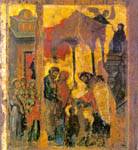|
|
| Portable Icons |
early 14th c. Chelandari Monastery Wood, egg tempera, 110 x 96 cm |
|

|
This icon of the Presentation of the Virgin, which is a masterpiece of Palaeologan art, must have occupied a very special place in the liturgical life of the monastery, because the monastery celebrates its patronal festival on the Feast of the Presentation. The icon was probably one of the despotic icons on the original templon in the katholikon. The protagonists in the scene -Mary's parents Joachim and Anne, Mary herself, and the high priest Zacharias, who welcomes her - are grouped in the centre of the composition, before the canopied altar. On the right, behind Zacharias, on a stepped seat in the inner sanctum of the temple sits the Virgin being fed by an angel, in accordance with the account in the Apocryphal Gospel and ecclesiastical hymnology. Behind the Virgin's parents and in front of a tall narrow building are the Virgin's friends, the seven taper-bearing daughters of Zion, depicted realistically but on a smaller scale than Zacharias, Joachim, and Anne. The icon, which reflects the account in the Protoevangelion of James, adopts a traditional iconographical format that was established as early as the Macedonian and Comnenian periods and is seen in the Menologion of Basil II and the mosaics at Daphni (Lafontaine-Dosogne 1964-5, pp. 136ff., pls. XXXIV, 80, XXXV, 83). Typical of the conservative iconography of the scene is the fact that the Virgin's parents precede the daughters of Zion, whereas in the Palaeologan period they are usually depicted behind them, as in Chora Monastery (1318-21) and Studenica (ca. 1315; Lafontaine-Dosogne 1975, pp. 179ff., fig. 18). From an artistic point of view, despite the damage to the paint film, the figures of Joachim, Anne, and Zacharias are robust and wide-bodied. By contrast, with their classical tunics, slender build, graceful poses and movements, and faces of Hellenic beauty, the delicate taper-bearing daughters of Zion clearly reflect the classicising trends of the Palaeologan period, which are so manifestly apparent in the frescoes in the Protaton (ca. 1290). The figure which best typifies the classicism of the age is the girl at the extreme left, who is depicted with the loose stance of ancient funerary figures. The way she uses her hand to shield her flame from the wind introduces a realistic note hitherto unknown in the iconography of this scene. As regards technique, the full, fleshy faces with sharp olive-green shadows on the ochre, a slight blush on the cheeks, accentuated cheekbones, and thick, supple, linear highlights bring to mind techniques seen in the frescoes in the outer narthex of Vatopedi Monastery (1312), particularly those executed by the artist who painted Christ Praying on the Mount of Olives, who has been linked with Panselinos's workshop (Tsigaridas 1996 (3), pp. 271-9, figs. 218-20, 232, 236). This icon, which is unquestionably one of the most outstanding works preserved in Chelandari Monastery from the time of the Serbian ruler Stephen Milutin, has been dated to the end of the second decade of the fourteenth century and linked with the work of one of the artists who decorated the katholikon of Chelandari (1318-21) and who reflects the artistic environment of Thessaloniki (Djuric 1964, p. 82. Bogdanovic - Djuric - Medakovic 1978, p. 86. Weitzmann et al. 1982, p. 140). However, this writer is of the opinion that the icon is in fact an outstanding work representative of the Palaeologan renaissance, executed by an exceptionally talented anonymous artist from Thessaloniki, who uses techniques that closely resemble those of the painter of Christ Praying on the Mount of Olives in the outer narthex of Vatopedi Monastery (1312). It is therefore proposed that this icon of the Presentation of the Virgin should be dated to the first decade of the fourteenth century and dissociated from the artists who decorated the katholikon of Chelandari.
| |
|
Bibliography: Radojcic 1955 (1), p. 174, fig. 27. Radojcic, Icτnes, p. 24. Djuric 1964, pp. 81-2, figs. 32, 33. Weitzmann et al. 1966, p. LXVI, figs. 194-5. Bogdanovic - Djuric - Medakovic 1978, p. 86, figs. 72-3. Weitzmann et al. 1982, p. 176.
| ||
| E.N.T. | ||
| Index of exhibits of Monastery of Chelandari 14th century |
||
Reference address : https://www.elpenor.org/athos/en/e218ab15.asp